Contributory members are able to log private notes and comments about each site
Sites Anne T has logged. View this log as a table or view the most recent logs from everyone
Hall Well (Irthington)
Trip No.40 Entry No.2 Date Added: 24th Aug 2017
Site Type: Holy Well or Sacred Spring
Country: England (Cumbria)
Visited: Yes on 20th Aug 2017. My rating: Condition 2 Ambience 3 Access 5
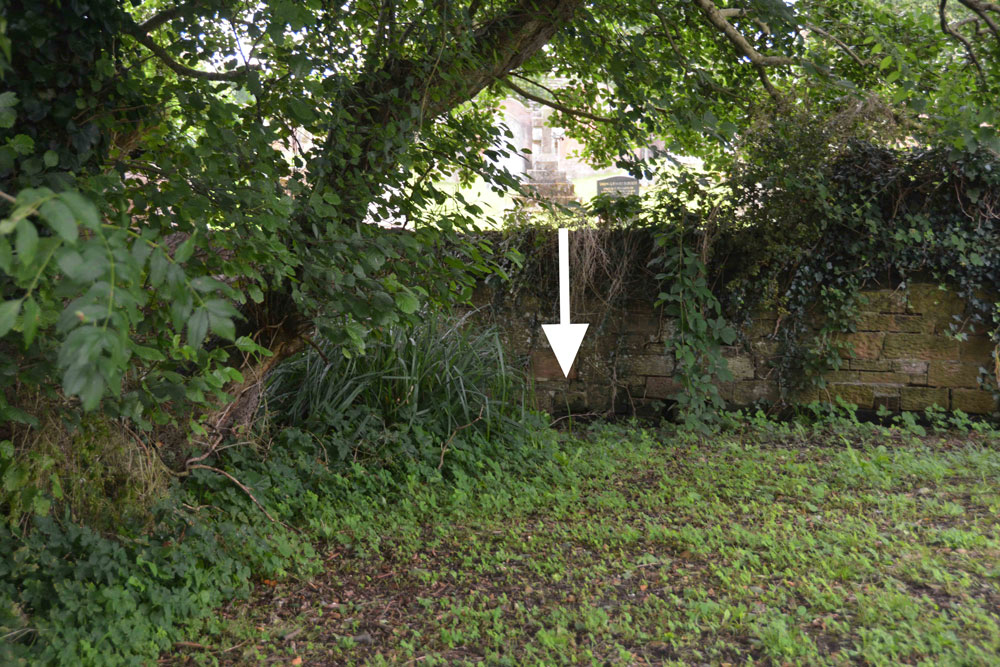
Hall Well (Irthington) submitted by Anne T on 24th Aug 2017. At the southern end of this small grassy area is a boggy area. Just underneath the wooden fence into the neighbouring garden a stream appears from under the bank. This stream has a good flow of water.
(View photo, vote or add a comment)
Log Text: Hall Well, Irthington: From Walton we made our way over to Irthington – not a planned visit, but because I saw the holy well and 2 mottes in close proximity in this village.
This small village (too large to be called a hamlet, but too small to be a good sized village) is obviously old. It’s not that far from Carlisle Airport and stands on the line of Stanegate and is also close to the line of Hadrian’s Wall.
Being armed with the OS map and a GPS, we went in search of the holy well first (passing by the first motte as we’d look for somewhere to park on the way back). According to the OS map the well lies not far outside the south-eastern wall of the church yard. Walking through the churchyard, this area is covered in brambles, nettles and shrubs, but we found some steps leading through the wall and onto the grassy area beyond. At the grid reference above there are some reeds and shrubs sitting in a boggy area. Peering over the fence into the garden of the house sitting immediately to the south, a stream suddenly appears out of the ground and rushes through the garden and is piped under the road, presumably to the modern water pumping station opposite. Nothing exists of any well housing (that we could see) and I’ve emailed the vicar through the ‘A Church Near You’ website.
Just down the road is one of the mottes. Note: the grid reference given by Pastscape indicates the site of the well is around the steps from the churchyard.
Irthington Mill
Trip No.40 Entry No.4 Date Added: 25th Aug 2017
Site Type: Misc. Earthwork
Country: England (Cumbria)
Visited: Yes on 20th Aug 2017. My rating: Condition 2 Ambience 3 Access 5
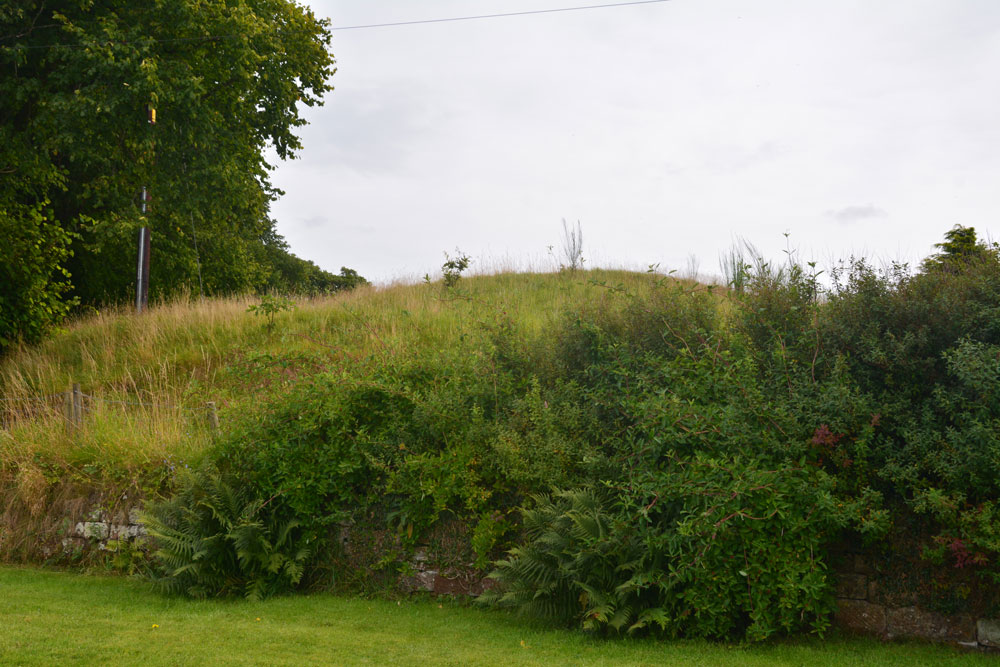
Irthington Mill submitted by Anne T on 25th Aug 2017. The 'motte' from near the driveway to Irthington Mill house. Fancy having part of your garden growing on such an old feature, especially if it is a motte!
(View photo, vote or add a comment)
Log Text: Irthington Mill 'motte or not?': Having spotted two mottes and a holy well just off the road we were travelling on to Carlisle, I asked to take a detour to find these. Whilst this is marked as a motte on the OS map, and certainly looked like one, I got home to find there is some debate about whether this is a motte or a natural feature (it is not recorded on Historic England’s listings).
Situated between a farm with some very old buildings and Irthington Mill house, with part of the Mill’s garden growing up its western slope, and not far from Irthington Bridge, it seemed to me that this motte was in a much more strategic defensible position near the modern day river crossing. Perhaps the course of the river moved over the years and the site of the motte was changed? This is me not wanting to belive its just a natural feature!
Bride's Well (Stapleton)
Trip No.40 Entry No.5 Date Added: 25th Aug 2017
Site Type: Holy Well or Sacred Spring
Country: England (Cumbria)
Visited: Yes on 20th Aug 2017. My rating: Condition -1 Access 4
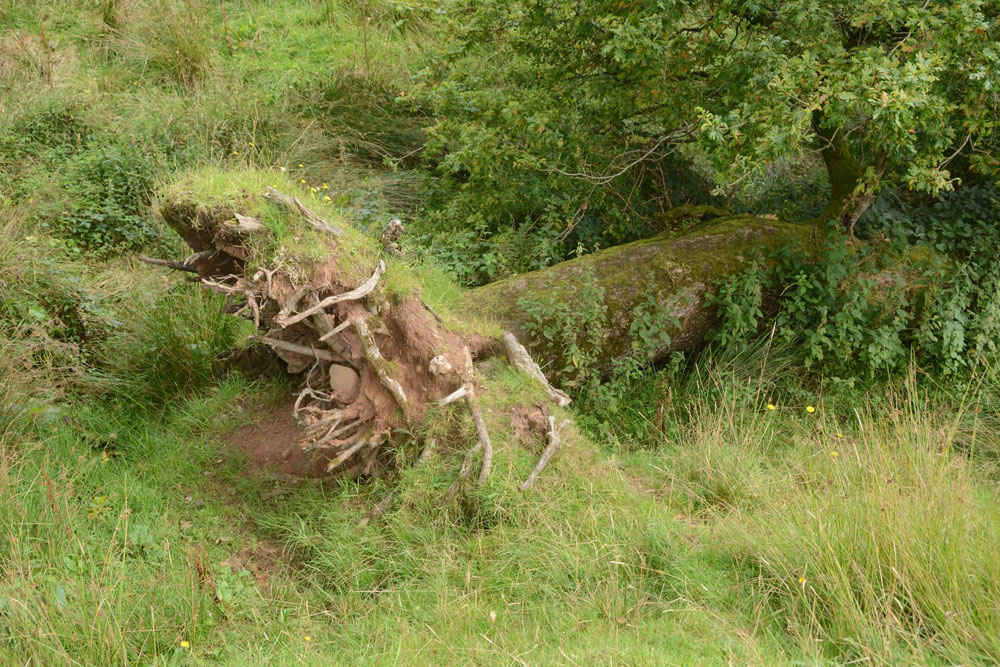
Bride's Well (Stapleton) submitted by Anne T on 25th Aug 2017. This was the fallen tree which lies over the position given for Bride's Well at St Mary's Church in Stapleton, so it may possibly be destroyed. The church warden I contacted thinks the well is in a field behind the vicarage and is going to check and get back to me.
(View photo, vote or add a comment)
Log Text: Bride's Well, Stapleton: Now underneath a fallen tree? Having had to run away from this site to collect our cats from the vets after a very brief search for the well last Thursday, we went back armed with the GPS and OS map and found we’d been looking in the wrong direction.
I’d seen a set of stile leading down to the meadow from the eastern side of the church yard so we found these. They led down to the meadow and the burn running north-south through the field, although they were completely overgrown by nettles. Whilst there were only two small steps on the church yard side, there were around 8 going down into the field below.
We walked round and round and the only feature we could see at the exact grid reference given by Pastscape was this fallen tree. Has the well been destroyed? We had a good look round all along the stream in this field.
I sent an email to the Rector when I got home, and received the reply below. She thinks the well might be in the field behind the rectory, which is above the church, and will check and send an update.
Dacre Church
Date Added: 6th Nov 2017
Site Type: Ancient Cross
Country: England (Cumbria)
Visited: Yes on 5th Nov 2017. My rating: Condition 3 Ambience 4 Access 5
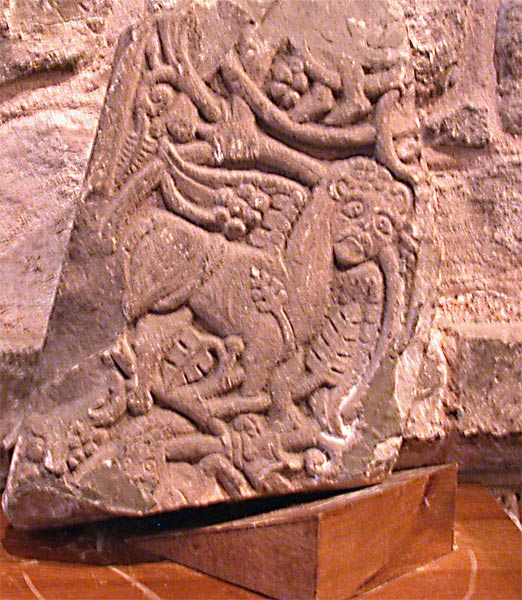
Dacre Church submitted by nicoladidsbury on 22nd May 2005. St Andrew's Church - 9th Century Cross Fragment.
This is the smaller fragment, which is believed to date from the 9th century, was found in 1900 close to the Church and deep in clay. It is considerably damaged but some detail of the carving is still quite sharp. The least damaged face of the shaft, where the top has been broken off, shows two pairs of human feet. Beneath is a lion-like winged creature, with a large face and sorrowful eyes, with the head and part of the body of a serpent.
(View photo, vote or add a comment)
Log Text: St Andrew's Church, Dacre: Anglo Saxon Cross Fragments: We'd visited this church back in early 2014, before I joined the Portal, to photograph the bears; the church was firmly locked on the day of our visit. This time, the door was open, and we walked into this lovely church, parts of which are extremely old. The smell of the nave was reminiscent of the church where I used to sing in the choir when I was 10/11 years old - it's been a long time since I was reminded of those ancient days!
I'd called up the Corpus of Anglo Saxon Stone Sculpture website, which showed four recorded stones for Dacre. We could only find 3 (2 of them combined in the Dacre entry), Dacre 3 having been removed to Lancaster University. Despite an intensive hunt, Dacre 1 was also not to be found.
Dacre 4, in the exterior south wall of the chancel took some finding; to my very untrained eye, the motif could have been weathering. Glad I have the Corpus image to refer to, and then it took two of us well over five minutes to find it!
Mossthorn Long Cairn 1
Trip No.60 Entry No.3 Date Added: 24th Nov 2017
Site Type: Cairn
Country: England (Cumbria)
Visited: Yes on 20th Nov 2017. My rating: Condition 2 Ambience 4 Access 3

Mossthorn Long Cairn 1 submitted by Anne T on 24th Nov 2017. Approaching the northern end of the this long, rectangular cairn, which was made up of small to medium sized stones and earth.
(View photo, vote or add a comment)
Log Text: Mossthorn Long Cairn, Copt Howe, Newton Reigny: We wrote to Mossthorn Farm immediately after our last visit here in February 2017, but our letter was ignored and we didn’t get a reply. A local historian, who we’d made contact with to find out more about the standing stones / stone row said he had contacts who would give permission for us to visit, but nothing.
In our latest visit to Newbeggin, we went armed with wellington boots and socks and trudged down the lanes from the southern side of Newton Reigny. Whilst the lane is gated, it looks to be frequently used by walkers, so we followed the footpath to Copt Howe at NY 48258 30770. The gate into the field was wide open and a large dung heap had been placed near the field gate. As the rest of the field was pasture, we decided to walk quickly over to the long cairn and take a closer look. The field was very boggy and I was glad of my wellies.
Strangely, I noticed lots of quartz stones scattered around the perimeter of the cairn, shining white in the drizzle amongst the brown-red earth. This cairn had plenty of stones down its length.
We saw the side of Mossthorn Long Cairn 2 that we hadn’t seen before from the eastern hedge line of the field but didn’t want to incur the wrath of the farmer, who was working on his tractor in the field nearby.
Newton Reigny Enclosure
Trip No.60 Entry No.2 Date Added: 26th Nov 2017
Site Type: Misc. Earthwork
Country: England (Cumbria)
Visited: Yes on 20th Nov 2017. My rating: Condition 2 Ambience 3 Access 5
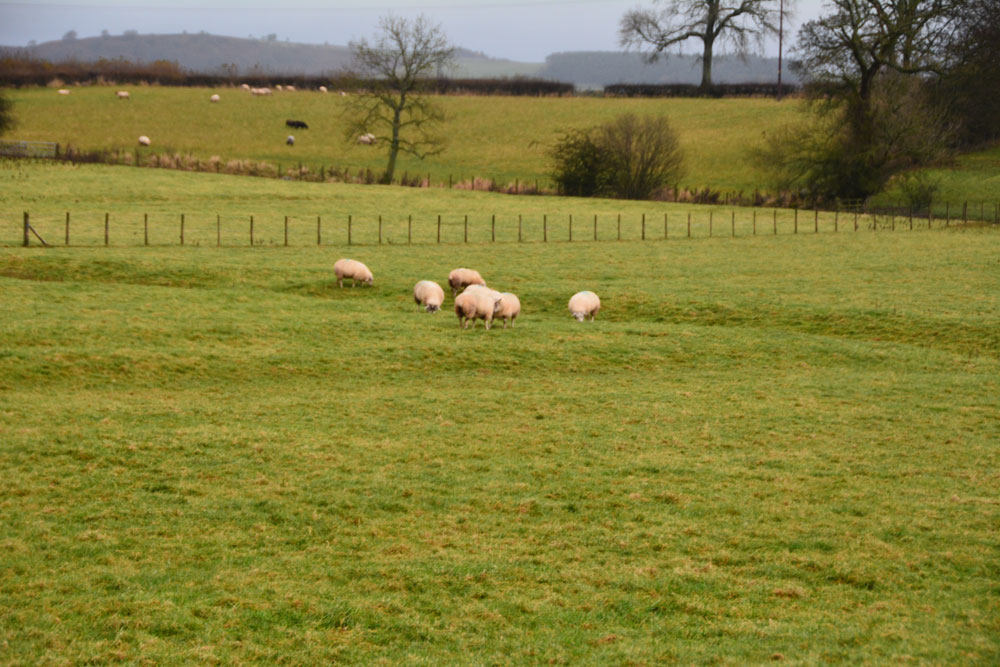
Newton Reigny Enclosure submitted by Anne T on 26th Nov 2017. Standing at the gate to the field containing part of this enclosure, looking north. A series of low banks and ditches can be seen, largely to the left hand side of the small cluster of sheep. Not a huge amount to be seen, but this site is believed to be of Dark Ages origin, according to the Curator of Carlisle Museum.
(View photo, vote or add a comment)
Log Text: Newton Reigny Enclosure: Having put the wellies in the back of the car, we decided to try and walk along the lanes from the south of Newton Reigny, where traditionally one of the stone rows ran towards Newbeggin. On our last visit, back in February 2017, the lane was ankle deep in water and mud.
I spotted this enclosure on the map, and keen to see something other than possible (non-existent) standing stones, was keen to see something of historic value. There were road works immediately opposite the field this enclosure was in, and the workmen, who were partly blocking the road waved us through. We, however, didn't want to be waved on, so my husband drove just past where they were working and I hopped out with the camera, much to the amusement of the workmen who must have wondered what we were looking at.
There were the outlines of low banks and a deeper ditch criss-crossing the field. Not a huge amount to look at, but worth stopping to look at. On looking at the information available on Pastscape and Historic England, this is a scheduled site. It is just to the east of the church of St. John in the village
St Luke's Church (Townhead)
Trip No.66 Entry No.1 Date Added: 10th Feb 2018
Site Type: Ancient Cross
Country: England (Cumbria)
Visited: Yes on 9th Feb 2018. My rating: Condition 3 Ambience 4 Access 5

St Luke's Church (Townhead) submitted by Anne T on 10th Feb 2018. Standing just to the south west of the cross base and shaft, looking at the southern wall of the church. No carvings are evident on this side of the base or cross shaft, although there is a large depression towards the top of the cross shaft, which looks like it has been damaged at some point.
(View photo, vote or add a comment)
Log Text: Ancient cross, St. Luke's Church, Townhead, near Ousby. OK, so the weather was supposed to be better the further west we went, so we took the option of travelling to this site via Alston and the high moors. A bit of a mistake, as there was much more snow here than at home, but it was lovely, if a bit of a slow drive. The roads within Ousby village were quite complex for such a small village, and we managed twice to take the wrong turn, but finally ended up at this very small hamlet.
Parking is available just to the west of the church, where the road widens, although walking to the gate of the church was tricky as it was quite a busy road, with farm traffic and lorries (considering the road is a dead end, I wondered where the traffic went).
No-one had been in the churchyard since the snow had fallen, so we picked our way up to the north door. The church is relatively plain inside, until you walk up to the chancel, where there is the most fantastic carved effigy, made out of wood and now encased in a glass/plastic case to preserve it. Half of this has broken off, but I was glad we'd gone inside the church to see this. There was no church guide, or any notes for visitors, and I haven't been able to find out much about this since.
The cross base and remnant of cross shaft are to the south of the nave/chancel, almost on top of a tall, red sandstone grave stone. We could see no markings or carvings on the cross shaft or base, apart from a shallow carved cross on top of the shaft, with small 'cups' as terminals.
The snowy hills in the background made this quite an atmospheric place.
St Lawrence's Church (Kirkland)
Trip No.66 Entry No.2 Date Added: 10th Feb 2018
Site Type: Ancient Cross
Country: England (Cumbria)
Visited: Yes on 9th Feb 2018. My rating: Condition 3 Ambience 4 Access 4
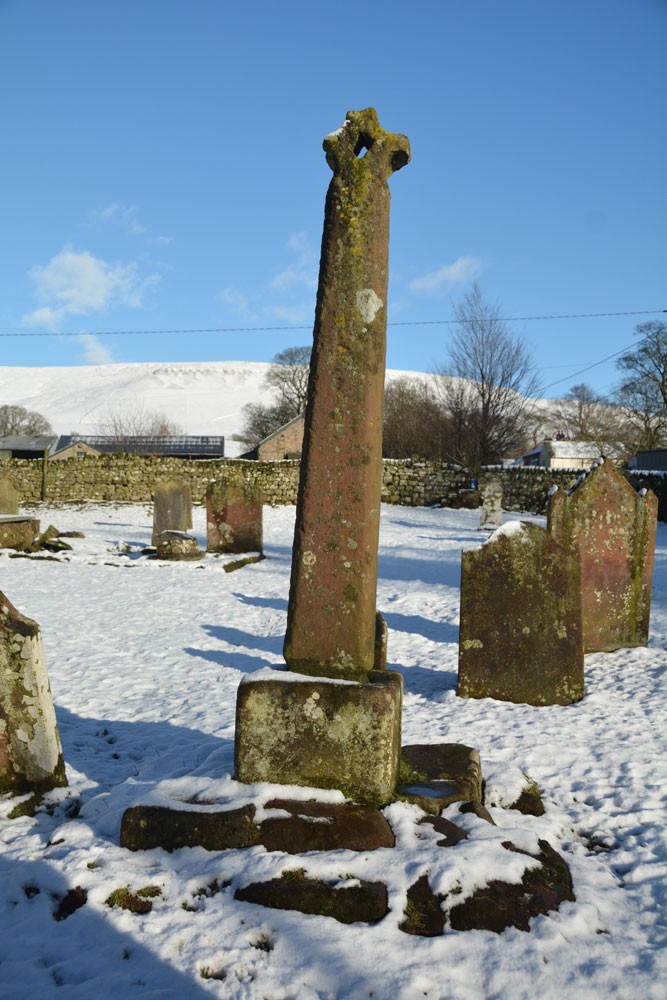
St Lawrence's Church (Kirkland) submitted by Anne T on 10th Feb 2018. Looking due east across one of the broad faces of the cross. I wondered where the small fragments of broken arm were; they weren't in the church, as we searched around for these. Probably long lost.
(View photo, vote or add a comment)
Log Text: Ancient Cross, St Lawrence's Church, Kirkland, Cumbria: The church itself is unremarkable, although a pretty stream runs just outside the southern wall of the churchyard. Parking is available just outside the church, on the grass, although on the day of our visit it was snowy and the ground was boggy, so we parked just over the bridge, just east of the T-junction.
The church was being renovated, so to avoid the scaffolding and a muddy walk right round the churchyard from the gate at the north-western edge of the church, we hopped across the small wire fence, meant for containing the sheep.
The cross is tall and slender, but with broken arms. We observed two channels in the base, where the cross shaft meets the base, from which melting snow water was running. On another cross base near Cairnpapple, Canmore recorded that similar channels were thought to be from the base being used as a drinking trough at some time in its past. Here, the channels seemed to serve as a way of getting rid of water which might run down between the cross shaft and its base.
Certainly a remote spot here, although plenty of farm traffic.
St Cuthbert's Church (Milburn)
Trip No.66 Entry No.3 Date Added: 10th Feb 2018
Site Type: Ancient Cross
Country: England (Cumbria)
Visited: Yes on 9th Feb 2018. My rating: Condition 2 Ambience 4 Access 5
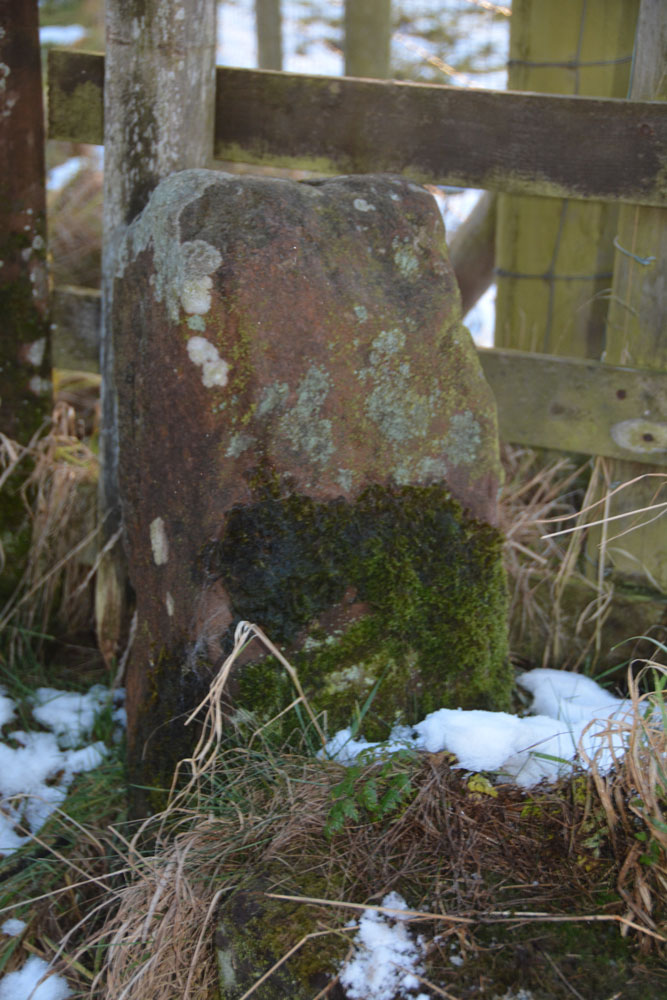
St Cuthbert's Church (Milburn) submitted by Anne T on 10th Feb 2018. Looking at the eastern face of the cross shaft. No carvings were visible on this face, and being so close to the fence and gate, it was difficult to get a clear look at the western and northern sides.
(View photo, vote or add a comment)
Log Text: Ancient cross and pre-Conquest sundial, Milburn, Cumbria: We scouted all around the churchyard for this cross, only to realise it was at the head of the access road from the village, so back-tracked to find it. It sits right by the northern gate post and we had mistaken it for part of the gate/fence structure, then we checked the grid reference and saw the hole in the top of the shaft, presumably either for another section or a smaller cross.
Going back down to the church, I found the pre-Conquest sundial, which is low down on the exterior stone door jamb of the western side of the south door. Thankfully I was able to pull up the Corpus of Anglo Saxon stone sculpture photograph to help me in the growing dusk.
The churchyard is really nicely kept and the Crowdundle Beck/Milburn Beck runs by the western side of the churchyard. A remote, by lovely spot.
St Edmund's Church (Newbeggin)
Trip No.66 Entry No.5 Date Added: 10th Feb 2018
Site Type: Ancient Cross
Country: England (Cumbria)
Visited: Yes on 9th Feb 2018. My rating: Condition 2 Ambience 4 Access 5
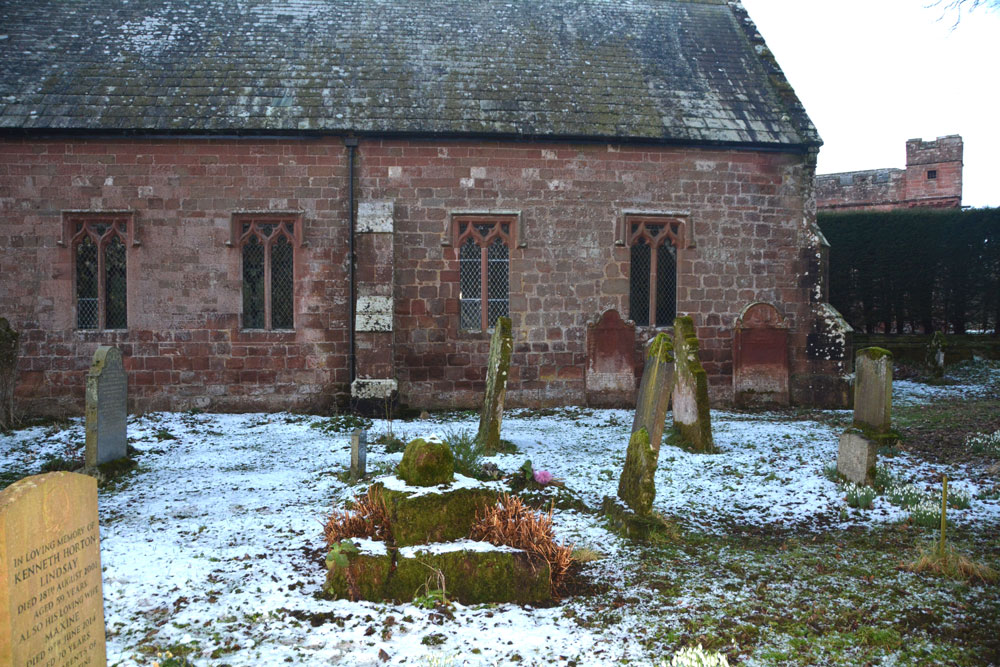
St Edmund's Church (Newbeggin) submitted by Anne T on 10th Feb 2018. Standing to the south of the cross base and shaft fragment, showing its proximity to the south of the nave/chancel.
(View photo, vote or add a comment)
Log Text: Cross base and remains of cross shaft, St. Edmunds Church, Newbeggin (Culgaith): We arrived here as dusk was dropping fast, so all my photos had to be taken with flash. Surprisingly, the church was still open, so we popped inside, but apart from a reading light near the pulpit, couldn't find any light switches. The church is a lot larger than it looks, and the grave yard is very full, so we had to pick our way over the graves and host of snowdrops to get to the cross.
The sundial nearer to the western churchyard wall was also interesting, although part of its lead gnomon had been pulled off.
It was very heavily encrusted in moss, and not wanting to damage it, left it without seeing if there were any carvings or features on it. Another church next to Crowdundle Burn (as is St. Cuthbert's in Milburn). A pretty spot. By the time we'd finished here, it was almost dark, so reluctantly had to set off back home.
Edenhall Cross (Langwathby)
Trip No.68 Entry No.1 Date Added: 6th Apr 2018
Site Type: Ancient Cross
Country: England (Cumbria)
Visited: Yes on 5th Apr 2018. My rating: Condition 3 Ambience 4 Access 5
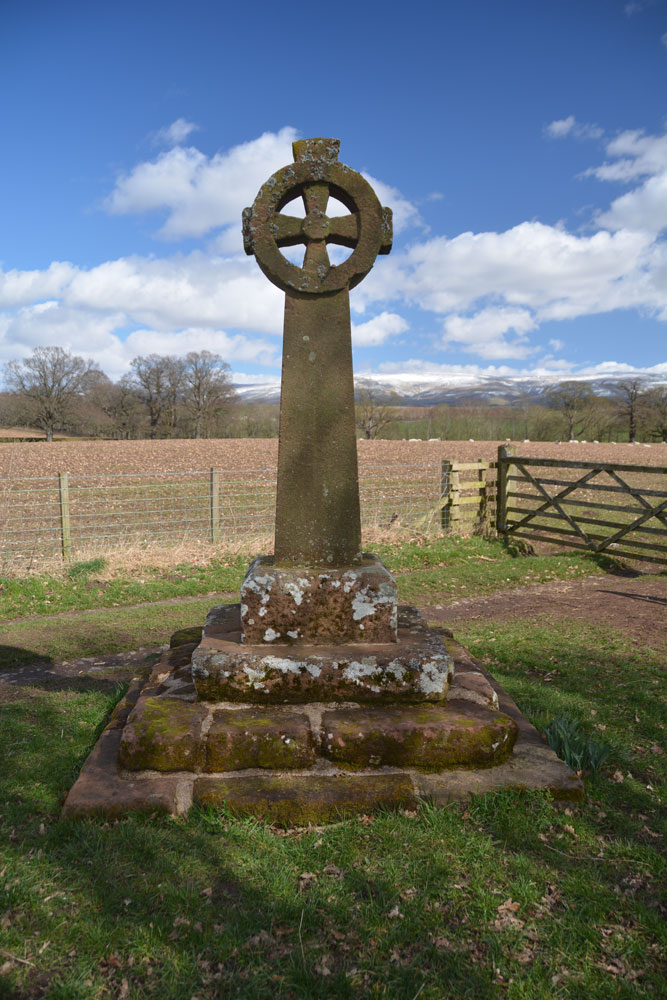
Edenhall Cross (Langwathby) submitted by Anne T on 6th Apr 2018. First view of the cross from the lane leading from Edenhall village to St. Cuthbert's Church. The River Eden runs 250 metres east of the cross. St. Cuthbert's church is 230m south east of the cross. The base looks very old, whereas the cross and shaft and head look as if they have been newly made, even though they were placed here in the 19th century.
(View photo, vote or add a comment)
Log Text: Edenhall Cross, near Langwathby, Cumbria: This is one of the crosses we didn't have time to visit on our last trip to Cumbria, and we picked a beautiful, if somewhat chilly day, to arrive.
No sooner had we pulled the car up by the cross to take some photographs, and I was wrestling with the lens of my camera, which had jammed, when a dog walker sidled up and asked us if we were planning on parking there. I said I was just going to take some photos, then we were heading down to the church; we wouldn't dream of blocking the gate into the field. The man looked mollified and moved on, only to be followed by a steady stream of dog walkers with large dogs.
The view across to the Pennines with their snow caps was lovely. The photographs didn't really do the scenery justice. A lovely spot.
St. Cuthbert's Church (Edenhall)
Trip No.68 Entry No.2 Date Added: 6th Apr 2018
Site Type: Ancient Cross
Country: England (Cumbria)
Visited: Yes on 5th Apr 2018. My rating: Condition 3 Ambience 4 Access 5
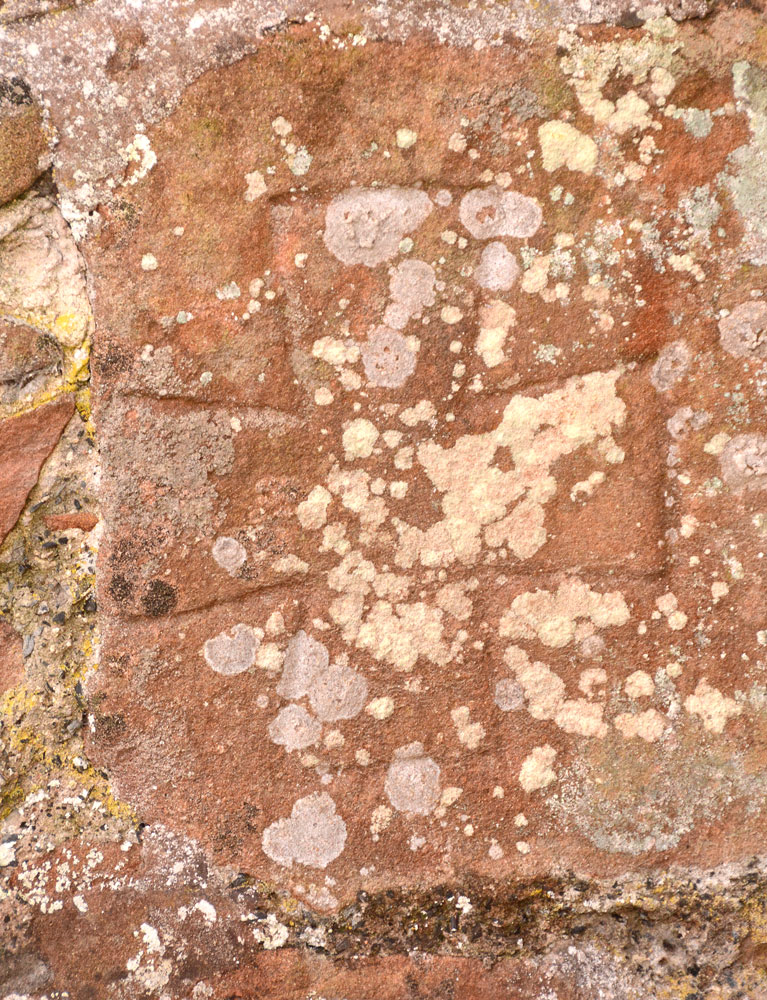
St. Cuthbert's Church (Edenhall) submitted by Anne T on 6th Apr 2018. Close up of the carved Anglo Saxon cross in the exterior north of the wall. Just to its east, and higher up the wall, is a blocked up Anglo Saxon window/window head.
(View photo, vote or add a comment)
Log Text: Anglo Saxon Cross at St. Cuthbert's Church, Edenhall: There is a small car park to the north of the church, and a tall/wide gate with a stile next to it to access the churchyard. This is a pretty, red sandstone building which looks as if it has been extended many times in antiquity.
There was no mention of anything on the Corpus of Anglo Saxon Stone Sculpture, although the church guide book mentions “the chancel appears to be pre-Norman or early Norman origin, and a small blocked up window high up in this wall is of Anglo Saxon type. Moreover, on the same wall, lower down, there is a carved Anglo Saxon cross. Thus the north wall may be the remains of an earlier church.”
The guide also mentions a Mass Dial on the south wall, to the east of the porch. We both spent about 20 mins looking up and down the length of the wall, both east and west of the porch, in strong sunlight which would have brought the markings out, but failed to find this. We did spot what looked like two fragments of carved cross shaft in the south wall of the tower, west of the porch. There was no mention of these in the guide or Pastscape or HE notes.
Roman Milestone (Temple Sowerby)
Trip No.68 Entry No.3 Date Added: 6th Apr 2018
Site Type: Marker Stone
Country: England (Cumbria)
Visited: Yes on 5th Apr 2018. My rating: Condition 3 Ambience 3 Access 5
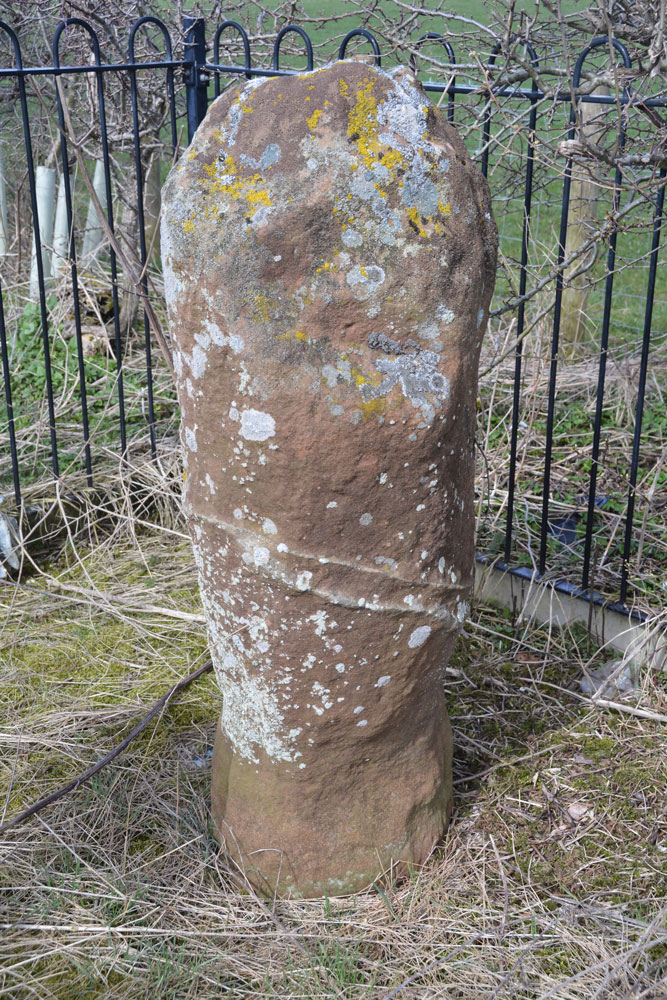
Roman Milestone (Temple Sowerby) submitted by Anne T on 6th Apr 2018. Close up of the southern face of the milestone. If there was an inscription, it has long been scoured away by the winds and rains. Today the A66 Temple Sowerby by-pass rushes by just to the west of this milestone. To think this has sat by a routeway for around 2,000 years.
(View photo, vote or add a comment)
Log Text: Roman Milestone, in its original position, Temple Sowerby: This was a very curious site - now a newly created 'dead end' and technically a private road. The milestone is hidden behind a mound of dirt and stones at the side of the road, protected by a metal railing. Traffic on the he modern A66 Temple Sowerby by-pass whizzes by at high speed. Shame the railing and hedge behind attracts so much rubbish - really spoiled the ambience.
To think this has been on an ancient routeway for such a long time. The weather has long scoured away any inscription. I have been trying to find out how they know it's in its original location, but haven't found out anything (yet).
St Michael (Lowther)
Trip No.68 Entry No.4 Date Added: 7th Apr 2018
Site Type: Ancient Cross
Country: England (Cumbria)
Visited: Yes on 5th Apr 2018. My rating: Condition 3 Ambience 3 Access 5
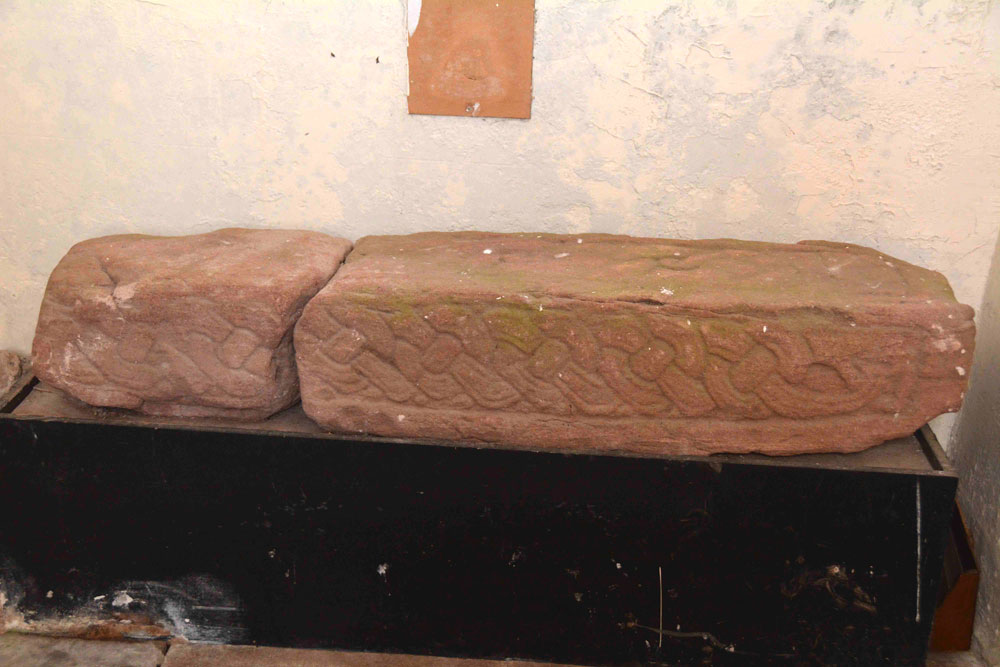
St Michael (Lowther) submitted by Anne T on 7th Apr 2018. This grave cover, now broken into two parts, can be found against the western wall of the porch. It is recorded as AS Corpus Lowther 07a-b and is dated to the 10th century.
(View photo, vote or add a comment)
Log Text: Ancient Cross and hogback fragments, Lowther: We arrived here eager to see the hogback and grave covers detailed on the Corpus of Anglo Saxon Stone Sculpture Volume II, but on arriving at the church, the door appeared to be locked. There were a few broken panels in the south window of the porch, so I resorted to trying to take photos through the window, but there was no light. I called up the Corpus on my phone to see what might be in the churchyard rather than inside the church and came up with Lowther 10, which is built into the retaining wall of the churchyard where it drops down to the River Lowther, 9m from the south west corner of the church. Andrew walked all the way round, whilst I stayed in the churchyard marking the spot, but despite having the Corpus photograph, this stone appeared to be too worn to identify.
In disappointment, I went and rattled at the church door again, a little more boisterously than before and as I let the handle go, heard the latch click and the door came open. We made our way inside the church. There are supposed to be a number of fragments in the porch, but only found 2 that are recorded on the Corpus.
There are three more fragments tucked away against the west wall of the north transept, and I had to go and get my large flash gun to take photographs. Only two of these are recorded on the Corpus.
This is a really strange church. Despite its size, it feels more like a mausoleum rather than a church, and I was glad to get out into the sunshine to find the cross in the churchyard.
Castlesteads (Yanwath Wood)
Trip No.68 Entry No.7 Date Added: 7th Apr 2018
Site Type: Ancient Village or Settlement
Country: England (Cumbria)
Visited: Yes on 5th Apr 2018. My rating: Condition 2 Ambience 3 Access 3
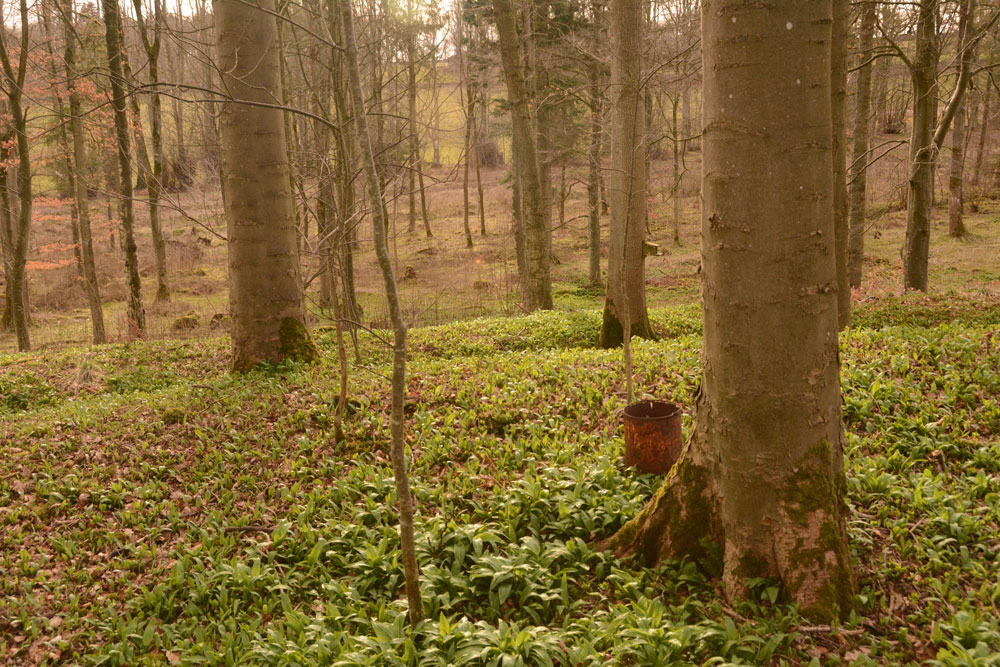
Castlesteads (Yanwath Wood) submitted by Anne T on 7th Apr 2018. Standing just inside the inner bank on the north western side of the enclosure looking across a ditch and two banks.
(View photo, vote or add a comment)
Log Text: Castlesteads (Yanwath Woods), Cumbria: This hillfort/enclosure is a pleasant stroll away from St. Michael’s Church and Lowther Castle, along footpaths and forest tracks, crossing the River Lowther either on the road or the footpath. After crossing the river, we followed the forest track north then to the west when the track split some 100 metres or so after the river crossing. The track following the river was full of dog walkers from the nearby holiday/caravan park, although heading up into the forest, it was peaceful and calm.
This was a very strange site, as there is higher ground to the north/north west of this enclosure. There were some huge boulders within the interior of the enclosure. Some made up what seemed to be wall lines, others just seemed scattered about.
The northern part of the enclosure seems to have been clipped by the construction of the forest track, and this has removed the outer banks and ditches on this side.
Tullie House Museum
Date Added: 29th Apr 2018
Site Type: Museum
Country: England (Cumbria)
Visited: Yes on 20th Apr 2018. My rating: Condition 4 Ambience 4 Access 5
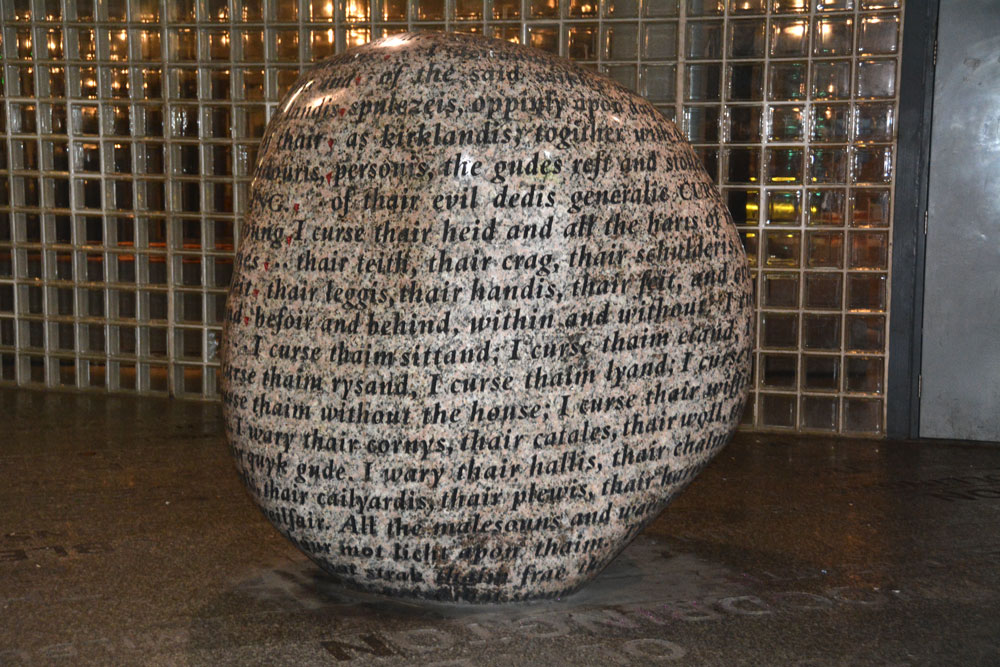
Tullie House Museum submitted by Anne T on 19th Sep 2017. Walking around the Cursing Stone - a bit difficult to photograph in what is largely a dimly lit pedestrian underpass with bright lights illuminating a few spots and shining off the stone.
(View photo, vote or add a comment)
Log Text: Tullie House Museum, Carlisle: We went to see the copy of the Bewcastle Cross and the Anglo Saxon cross fragments I'd seen photos of some years ago. The Bewcastle Cross copy no longer stands in the main entrance lobby, but is now in storage, and there are only a couple of rock art panels on display, along with Celtic gods (all displayed behind glass).
There was a very interesting video, and a display of associated artefacts, of the Langdale Axe factory.
A small museum, but interesting, even the Roman gallery in the basement, which has lots of interactive displays for children.
We bought a year pass for £10 each, which means we can return at any time for free until the end of April 2019. I've asked permission to go back to use their learning resource to find out more about the Celtic god sculptures.
Askerton Park
Trip No.69 Entry No.1 Date Added: 5th May 2018
Site Type: Ancient Village or Settlement
Country: England (Cumbria)
Visited: Yes on 23rd Apr 2018. My rating: Condition 2 Ambience 3 Access 4
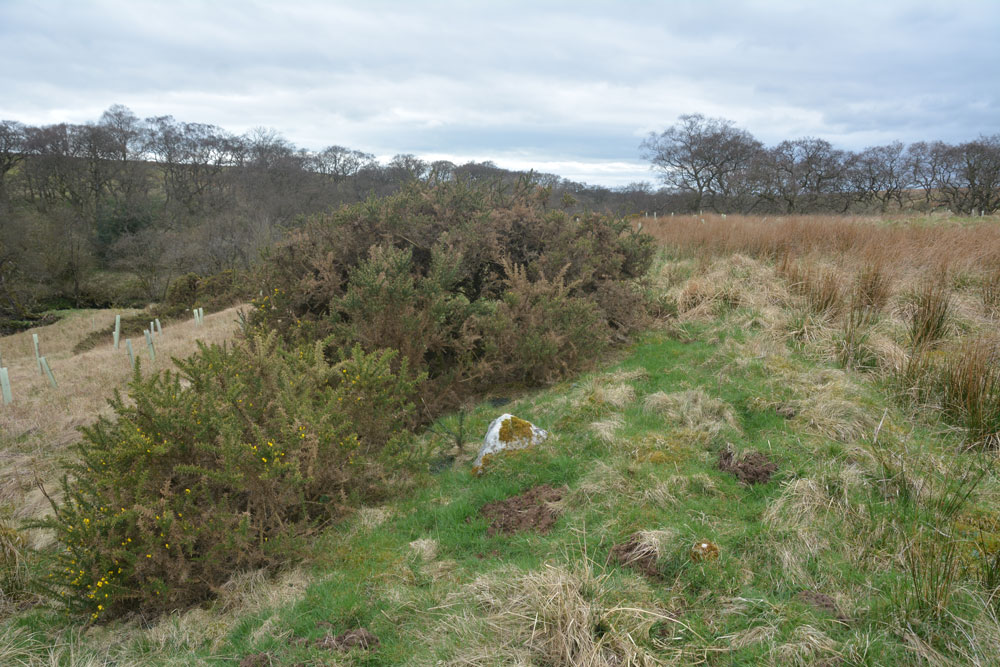
Askerton Park submitted by Anne T on 5th May 2018. Right in the middle of the settlement and just a little to its eastern side, there is a wide stoney bank which looks as if this may have been part of the main dwelling described in the Pastscape record. All around here the moles had been very active, and many shards of pottery had come to the surface.
(View photo, vote or add a comment)
Log Text: Askerton Park Settlement: This is marked on the OS map, so we stopped at the northern end of Parkgate Bridge, where there is room to pull off the road and put on our wellies. We let ourselves in through the gate and tramped over the fields, entering the settlement from its north eastern side.
This settlement is fascinating, as its basically on a promontory between the Cam Back and Melefarm beck. Hollow ways run from the eastern part of the settlement to the Cam Beck, and there is another hollow way which picks up almost half way across the settlement, leading to Cam Beck. Following the latter trackway to the burn, there are the obvious remains of a cairn.
It was really interesting walking across the tops of the enclosure banks, which stood out a brighter green with shorter grass than the surrounding wheat-coloured taller stalks. There were lots of stones in the banks. The moles had had a field day, and I picked up a couple of the many pieces of pottery that had come to the surface of a mole hill (I wasn't certain they were pots until I got home and saw the inclusions and felt the lightness of the pot as opposed to some odd shaped stones).
Priest's Well (Bewcastle)
Trip No.69 Entry No.3 Date Added: 6th May 2018
Site Type: Holy Well or Sacred Spring
Country: England (Cumbria)
Visited: Yes on 23rd Apr 2018. My rating: Condition -1 Ambience 3 Access 4
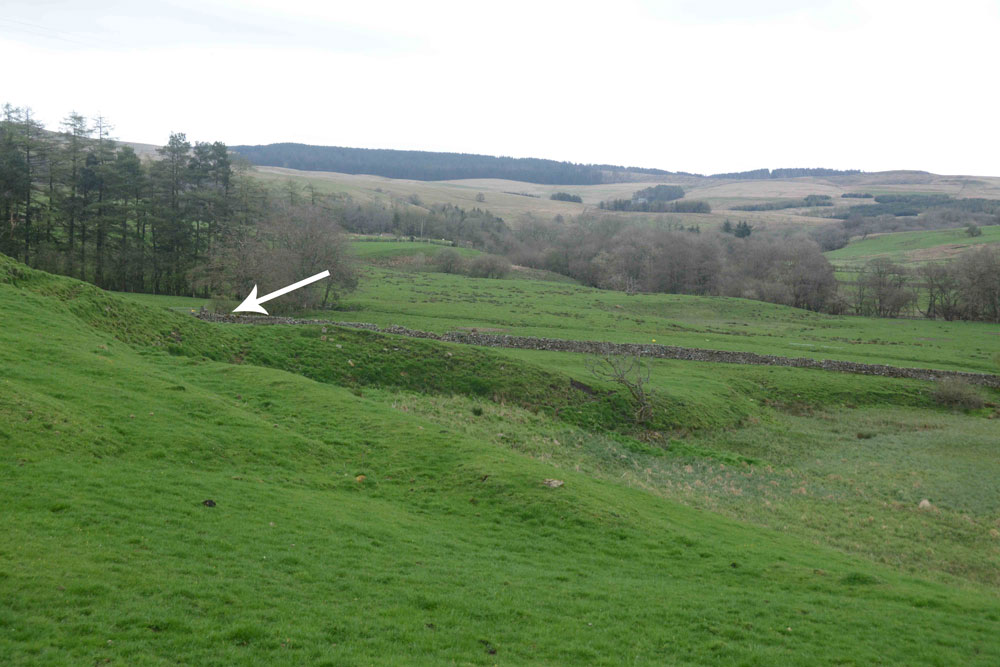
Priest's Well (Bewcastle) submitted by Anne T on 6th May 2018. This photograph was taken from the south eastern corner of the churchyard, the current landforms seeming to indicate that a spring once issued from here, disappearing into the Kirk Beck below.
(View photo, vote or add a comment)
Log Text: Priest's Well, Bewcastle (site of): As the ground was far too boggy to go and see the three cairns to the west of Parkgate Bridge, I found this well marked on the OS map, so we decided to go and see it. Arriving at St. Cuthbert’s and the Bewcastle Cross, we orientated ourselves with the map to find the well is actually on private farmland. The farmer was busy driving around the field in his tractor, so we decided we could probably see the well from the eastern end of the churchyard.
We did see some indication of where the site of the well was, but there was no well housing or water flowing. I could find very little information on this well, apart from the mention in the Old Cumbria Gazetteer, which says it is a spring. As I finished photographing the site of where the well probably was, drizzle started to hurtle down.
Long Stone (Barcombe Hill)
Trip No.70 Entry No.2 Date Added: 6th May 2018
Site Type: Ancient Cross
Country: England (Cumbria)
Visited: Yes on 5th May 2018. My rating: Condition 3 Ambience 4 Access 4
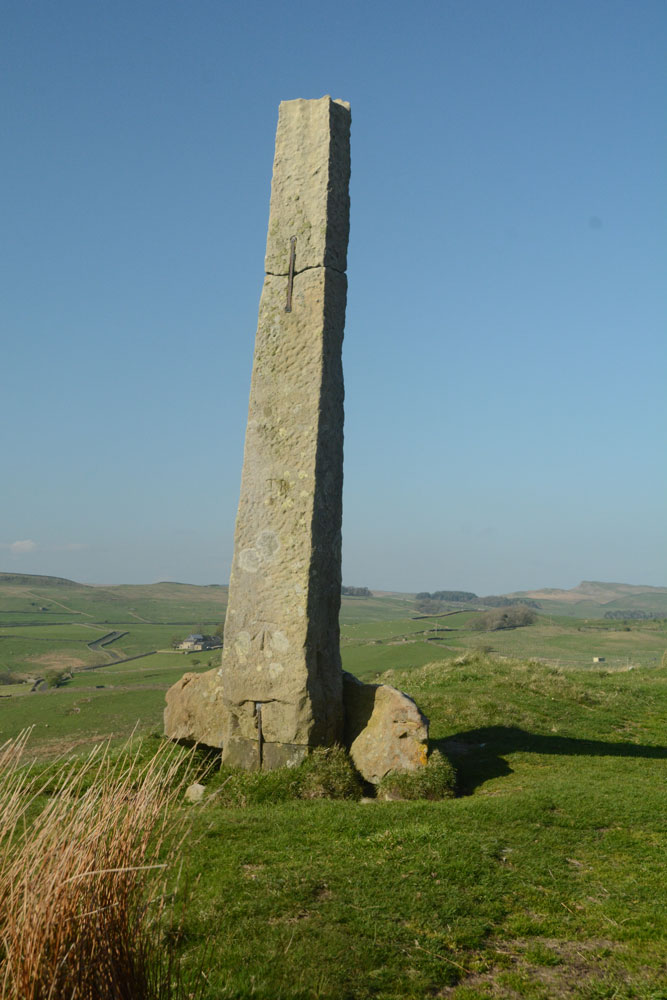
Long Stone (Barcombe Hill) submitted by Anne T on 6th May 2018. The Long Stone from the west, looking back towards Barcombe Iron Age defended settlement.
(View photo, vote or add a comment)
Log Text: The Long Stone, Barcombe Hill: we always thought this was a modern marker stone, sitting high above Stane Way. We also thought it was difficult to get to. Not so. There are well mown grass trackways that lead from Barcombe Iron Age Defended Settlement/Roman Signal Station, as well as from the Trig Point on Barcombe Hill. We approached from the trig point, which is higher than this stone and the settlement.
The whole stone and base are held together with large metal/iron rivets. The base looks as if it has been broken into two, and one half has been taken away. The top of the cross appears rounded upwards at the four corners, as if a cross head (or similar) was mounted on top.
The more time I spent here, the more I was convinced this was an old cross. What a location! With Vindolanda below, it is certainly a very prominent spot.
St Mungo's Church (Bromfield)
Trip No.81 Entry No.1 Date Added: 15th Aug 2018
Site Type: Ancient Cross
Country: England (Cumbria)
Visited: Yes on 9th Jul 2018. My rating: Condition 3 Ambience 4 Access 4

St Mungo's Church (Bromfield) submitted by Anne T on 10th Jul 2018. The dark red semi-circular stone is (the remains of) AS Corpus Bromfield 04, a 10th century hogback, as seen from the inside of the south porch. Located above the main door of the church, we stood for ages trying to make out the original hogback. The wavy edge at the top of this dark red sandstone is the only clue. According to the AS Corpus photos, the hogback can be better seen from inside the church, but the church was locked, so we were unable to see.
(View photo, vote or add a comment)
Log Text: Hogback and ancient crosses at St. Mungo's Church, Bromfield: Our first stop of the day. This is clearly an ancient village.
The church was locked, so the only stone we could see was in the porch – AS Corpus Bromfield 04. From the Corpus image, the top of the hogback looks clearer from the inside of the church, but of course we couldn’t get in.
After walking back from the well, I stopped to look at the hideous memorial in the southern part of the churchyard and noticed that it was built on what looked like the base of an old village/medieval cross. I haven’t been able to find anything out about this – it’s not mentioned in any literature I’ve currently come across – but suddenly it became more interesting!
We did try and find High Aketon Farm to see AS Corpus Bromfield 03, but couldn’t find it on the paper OS map and an internet search pulled up nothing. We decided to move on to the next location.
I’m going to try and contact the vicar to see if we can arrange entry into the church for sometime in mid-August.
